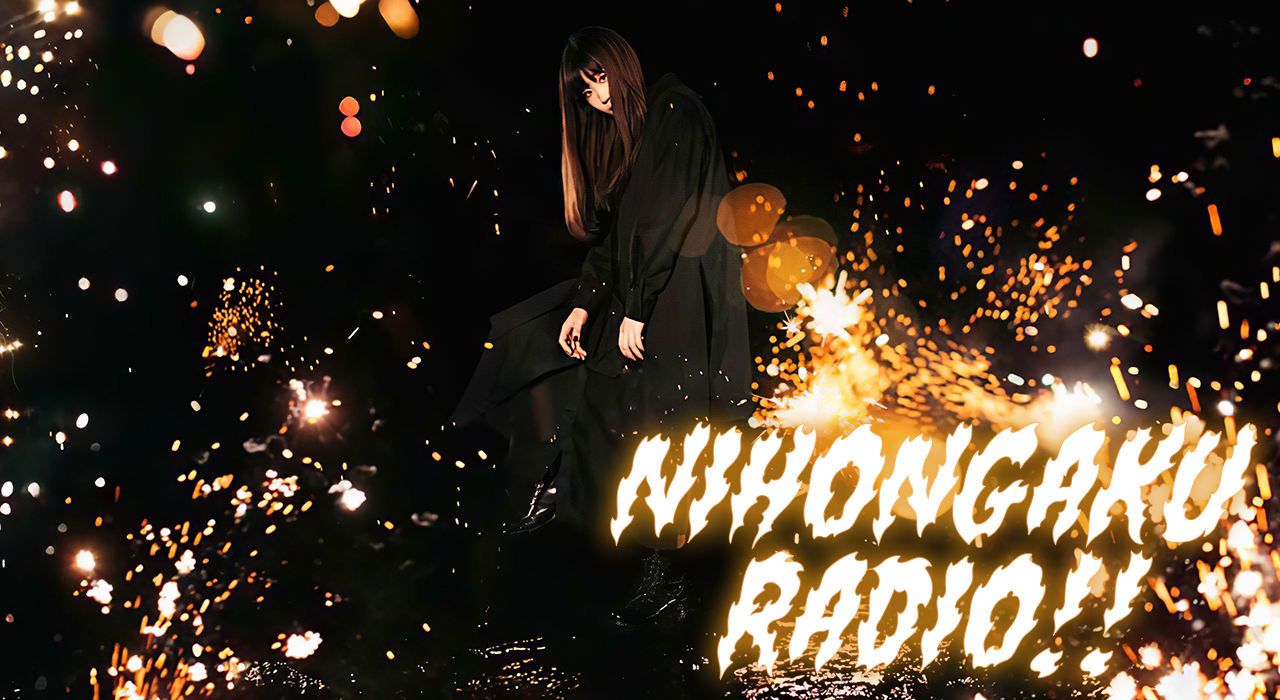Japan Nite 2013: SXSW’s Annual Japanese Music Showcase Hints At a Bright Future For J Music Fans
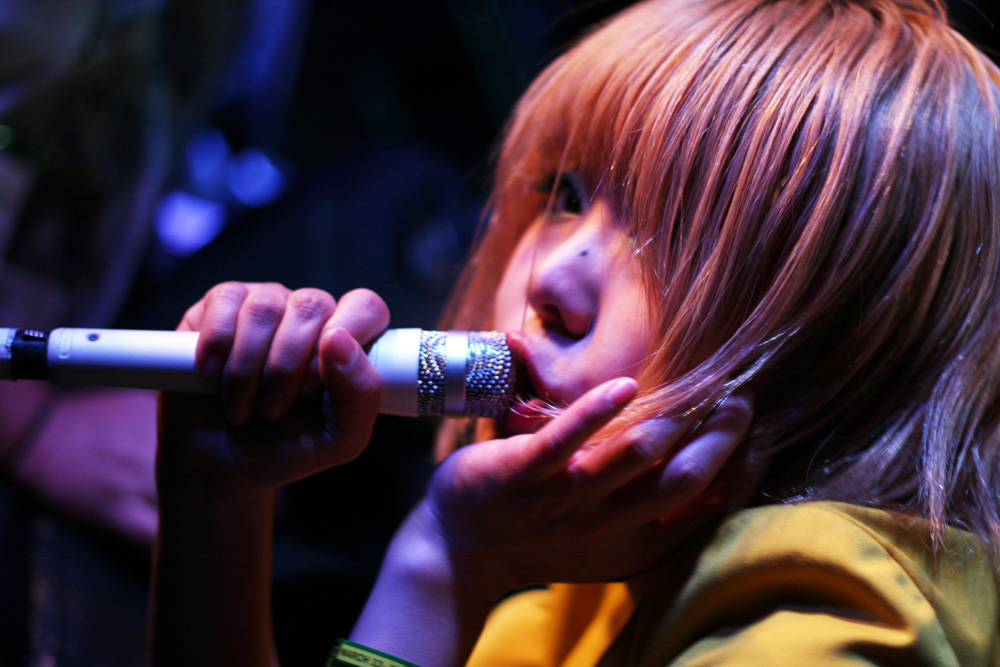
On stage, a woman is dying. Struck by invisible opponents, she gasps. Knees hit the floor. Her body falls back onto her legs and in another moment, she is motionless on the floor. A crystallizing silence hangs in the air. Despite the hundreds of audience members in attendance not even the whisper of a breath can be heard.
An acoustic guitar begins it’s rhythmic beat once more. She cries out, still alive. A shamisen joins in, producing those plucked tones unmistakably Japanese in origin. Her hands clasp an invisible rope and, wrist-over-wrist, pull her back from darkness. A shakuhachi flute, airy and piercing, strains the tension further as she stands. The woman turns. Her hands reach for a sword which she slowly unsheathes revealing a blood-stained blade inside.
“Hya!” The guitarist shouts and Hell breaks at his word. The instruments delve into a violent frenzy crying like devils with each strum, each pluck and breath. But devils are nothing to the woman striking with her blade, paying death upon those who betrayed her.
The performance is called “The Ogre of the Cherry Tree” and with it, a band called Kao=S opened the 18th annual Japan Nite, a Japanese music showcase held as part of the South by Southwest Music Conference in Austin, TX.
For Kao=S, this was an encore to their performance at last year’s Japan Nite, and they’ve only improved with time. The addition of a shakuhachi flautist and songs highlighting vocals from both singer and sword dancer Kaori Kawabuchi and Guitarist Shuji Yamagiri has elevated the band’s musical performance to the complexity of their on-stage theatrics. The sword dancing waits until the finale, but Kaori Kawabuchi’s flowing dance incorporating Noh theater masks and silken scarves ensure there’s something beautiful to keep your eyes on for the entire set.
Unique? Powerful? Yes. But in a Japanese music scene where pop idols like Kyary Pamyu Pamyu and Korean girl groups like T-ARA top the charts, Kao=S is an outlier to the mainstream—as are the rest of the bands billed for the Japan Nite showcase and the North American tour that follows. They are undiscovered talents waiting to be recognized, a trait classically shared by most of South By’s bands. But there are those who believe the music conference’s focus is changing.
Stand still long enough at a day party and you’re liable to hear from a jaded SXSW old timer eager to discuss how corporate South By has become between sips of Lone Star beer. It’s true that buzz abounded for heavy hitters like Justin Timberlake, Prince, The Smashing Pumpkins and The Flaming Lips this year. The rumor mill kept Austin guessing where Daft Punk was going to touch down for a secret performance. They didn’t. Macklemore fliers littered downtown Austin allowing the “Thrift Shop” artist to gobble up so much of that delicious SXSW limelight that legions of smaller acts barely got a taste.
Those badge-holding, multi-tour surviving bastions of South By yesteryear may have a point. Then again, there’s something undeniably special about an event that put Japanese artists on Texas soil for the better part of a week’s worth of performances.
Japan Nite alone would solidify SXSW’s importance in exposing American audiences to music from the Land of the Rising Sun, but several other Japanese bands trekked to Austin for the conference. SuiseinoboAZ performed at Metal & Lace, a tiny venue lead singer Masaharu Ishihara said he didn’t mind playing because it reminded him of the venues he’s used to in Japan. Right next door, The Mornings tore up Headhunters’ tiki lounge with their self-destructive brand of thrashing punk. Other notables performances include a handful of shows from Shugo Tokumaru, an instrumental band called LITE and the retro, beach-ready stylings of Teen Runnings.
Most of the Japanese bands performing SXSW joined up with the Japan Nite roster for the unofficial (and therefore free) “Japan Preview Day Show,” where they played twenty-minute sets in the parking lot of an East Austin bar called The Grackle. More often than not, bands who play the preview show return as part of the Japan Nite lineup the following year. Hystoic Vein, for example, played the preview show in 2010 before leaving the audience a sweaty mess when they rocked Japan Nite in 2011 and later as The ZZZ’s in 2012.
Music from Korea was also in no short supply during SXSW. Three days before Austin’s Elysium opened its doors to J music fans, it catered to an overflowing crowd eager to catch a glimpse of K-pop band Guckkasten and pop idol troupe F(x) during a showcase called “K-Pop Night Out.” Halfway through the showcase there was still a line down the block of fans hoping for people to exit Elysium so they could take their spot in the over-capacity venue.
The largest gathering of Japanese bands outside of the official Japan Nite showcase was the day show located in the aforementioned East Austin parking lot. In contrast, Korean artists on the Seoul Sonic Tour (Galaxy Express, No Brain, 3rd Line Butterfly) enjoyed swanky digs at the Spin magazine-sponsored “Spin House” located at an upscale beer garden and bakery known as Easy Tiger just off Austin’s legendary party strip, Sixth Street.
In his review for The Japan Times, Tokyo-based Japanese music writer Patrick St. Micheal characterized Japan’s SXSW performance as staying the course promoters set in the mid-’90s: namely bringing over as many interesting Japanese bands as possible and letting would-be fans find them on their own. Korean promoters, on the other hand, did everything they could to actively sell South By on K-pop. St. Michael credits Korea for the buzz generated in anticipation of F(x)’s SXSW performance and also tiny flourishes like monitors playing K-Pop music videos between sets at K-Pop Night Out. Japan Nite relied on Elysium’s house music between sets and an under-rehearsed host who stumbled over pronouncing the bands’ names like a bumbling high schooler inviting an underwhelmed crush to prom.
“Korean acts…were more in-tune with the festival’s hype-centric model,” St. Michael said. “The results showed that Japanese acts still sound great and can draw a crowd, but in terms of spreading culture, the Koreans are doing a better job.”
I agree with Mr. St. Michael’s notion that Japan Nite could use a little sprucing up. Some between-set music videos and social media savviness would go a long way toward spreading the J music gospel. But the fact remains that Japan Nite is the greatest concentration of Japanese music talent that North America has—a glorious mecca for Japanese music savants and the casually intrigued alike. No other tour or festival that I’ve seen comes remotely close, and the 2013 iteration was no exception.
Japan Nite’s longtime Austin home, Elysium, is a haven for goths and industrial music fans—the sort of place where a well-timed Flock of Seagulls track is all it takes to get ‘80s night moving. It’s cavernous with mirrored walls, laser light, two bars and a dirty patio fit for chain-smoking and watching backwards caps and hooker heels go in search of street food sustenance before returning back to the drunken dance clubs of Dirty Sixth.
By the time Kao=S took a bow, Elysium was packed and reluctant to quiet down even as the three petite ladies of Pirates Canoe took the stage in matching, hand-sewn outfits. Intricately-layered three part harmonies define this Kansai-based trio who weave together Americana music with a mandolin, a fiddle and a lead singer with a twangy drawl developed during a childhood spent in Arkansas. And they’re humble to boot.
“We have long wanted to play at SXSW,” said mandolin player Sara Kono between tunes. “Today is like a dream for us.”
Japan Nite is no stranger to cover songs. Saito Johnny melted hearts with a bluegrass take on The Buggles’ “Video Killed the Radio Star” and Daft Punk’s “One More Time” at last year’s Japan Nite. Punk band Lolita No. 18 also took a stab at The Buggles’ hit in 2011. Pirates Canoe followed suit, winning over the audience with a cover of The B-52’s “Love Shack” that they elevated to something more complex and beautiful than I would have thought possible of a classic but worn-out track that now makes its rounds on party compilations advertised on late night television.
Perhaps inspired by their time on the road with The Zukuna Sisters during the 2011 Japan Nite tour, the four femme fatales of Josy dropped a bluesy cover of “What A Wonderful World” into this year’s Japan Nite set. Where The Zukuna Sisters revel in perfectly recreating the thumping bass lines and full power vocals of American soul records from the ‘70s, Josy is creating something new; attitude-filled R&B filtered through the raw power of rock ‘n’ roll. Vocalist Kumi’s voice has got enough downlow blues to make you say “mmm hmm” and enough high-octane power to make your ears bleed.
But the star of Josy’s Japan Nite set was keyboardist Mami who pounded out licks with a sadistic glee. Josy does their thing sans guitar, but with a piano sound this in-your-face, you won’t miss the strings.
On the other hand, the members of power trio Jake Stone Garage were all about guitar-driven rock music. Vocalist and lead player Satoshi Watanabe looked pretty swanky showing up to a rock gig in a suit coat and a slick, K-Pop hair cut. But by the end of their set, the dude was playing his guitar so hard that sweat poured out of his sleeve and onto the stage.
“Himitsu,” a track from the band’s 2012 mini album Feels that’s full of screaming vocals and thunderous guitar riffs, was the highlight of Jake Stone Garage’s performance—though their cover of Nirvana’s “Smells Like Teen Spirit” came damn close. Matter of fact, Jake Stone Garage’s take on the grunge rock anthem’s guitar solo is the shattered exercise in melodic destruction it always deserved.
Chihiro Yamazaki backed up by the blazing hot Route 14 Band cut through the angsty alt-rock with instrumental jazz led by Ms. Yamazaki’s screaming trumpet.
“We hope music reaches your heart,” Yamazaki said before turning her note card and the responsibility for pronouncing its contents in passable English to her guitarist to finish. “We don’t have any vocals but instruments,” he said. “Beyond the border, right?”
Not just beyond the border but off the fucking map, Chihiro Yamazaki’s jazz faded away as the genre-defying duo known as Charan Po Rantan took the stage in outfits akin to what cake decorators might create if they had fabric instead of fondant.
If pressed, I’d say the two sisters of Charan Po Rantan (joined by a friend on drum for their Japan Nite performance) approach the bombastic madness of gypsy punkers Gogool Bordello with an E-for-everyone aesthetic replacing Gogol’s drunken debauchery. One sister jams out a ceaseless string of accordion notes while the other, one arm wrapped around a stuffed piglet like a security blanket made of bacon, belts out cutesy lyrics and channels Shirley Temple’s best dance routines.
Charan Po Rantan had long earned the award for most unique of the night’s performers when they pulled one last trump card from their bag of tricks and closed their set with a rendition of “Hava Nagila” that had the entire Elysium bopping like it was a bar mitzvah.
Later, when asked by Japan Nite organizer Audrey Benten what my favorite part of Japan Nite was, I would point back to Charan Po Rantan singer Momo jumping into a crowd chanting Hebrew lyrics and clapping along as this year’s shining moment. In stark contrast, a final performance by the half Japanese, half American generic rock band Four Minutes Til Midnight was its absolute worst.
“First time at SXSW and I think I fuckin’ fell in love with it,” said singer Eli Taylor. “Not gonna lie.”
Allow me to return the favor. You know how you instantly change the dial every time the alternative rock station forgets that 1995 happened a long, long time ago and finds it necessary to play 3-11 for the millionth time? Four Minutes Til Midnight doesn’t change the channel. They turn that shit up and worship at the feet of ‘90s alternative rock’s most unforgivable sins: poor rap flows, hookless guitar riffs that go nowhere and narcissistic preaching about how war is bad and stuff because it’s cool to have a message.
“This next song is about not causing a lot of violence,” Taylor says as if trying to decide whether or not it’s true. “So…yeah, we’ll go with that.”
There are a million bands like Four Minutes Til Midnight fizzling into obscurity in tiny rock clubs all over the United States. To have them in the headlining position for Japan Nite is a complete waste. A SXSW showcase legendary for its ability to bring unique acts from Japan to Austin deserves a better closer than these hackneyed reminders of alternative rock’s buried mistakes.
Despite a tragic ending, Japan Nite 2013 delivered on its promise to give American fans their annual fix of J music goodness. As is usually the case, I walked away from Elysium with a truckload of new CDs in my arms and a curiosity about what Japan Nite has in store for 2014.
It’s the Wednesday before Japan Nite and I’m standing in the Austin Convention center. SXSW Music officially kicked into gear yesterday, but there is still a ceaseless stream of people trekking from every corner of town to retrieve badges and wristbands—those precious symbols of the South By elite that allow access to all the showcases and parties. Behind me, a large space below an elevator that is empty for eleven months out of the year, has magically transformed into a Ford-sponsored lounge complete with Swedish-designed, white, faux-leather seats. I feel like a stranger in a futuristic alternate reality where life is measured in smart phone charges and the next big thing is always minutes away from blowing up.
I’m here to meet with members of an organization called Sync Music Japan, a confederation of producers and tour managers aiming to host Japanese concerts across the globe. Yeah, such an organization actually exists. And they’re pretty damn serious about the whole idea too. For example, Sync Music Japan is the group behind pop idol Kyary Pamyu Pamyu’s current world tour which includes a few stops in the U.S.
If anyone has their finger on the pulse of Japanese Music’s international potential, it’s Sync Music Japan Operation Manager Tadashi Goto who graciously takes a seat with me at a convention center table to discuss his organization’s strategy to market Japan’s biggest acts to the rest of the world.
He tells me that Sync Music Japan has supported the Japan Nite showcase at SXSW and the U.S. tour for years. Japan Nite producer Hiroshi Asada is on the Sync Music Japan board. It seems the show is in good hands as this year marks the first time the Japan Nite tour will head to Canada since Japan Nite 2007 artists graced the stage at Canadian Music Week in 2007.
Now they want to take the Japan Nite concept of showcasing multiple Japanese bands from different genres outside of Japan on an international scale—and the names Mr. Goto mentions are huge. Pop idols like Perfume and Kyary Pamyu Pamyu do better in Europe, he says, because of the fashion connection. On the other hand, bands with a link to Japanese anime tend to do better in the states because of our burgeoning base of would-be otaku. As a result, he said, we may see groups like JAM Project and L’Arc En Ciel team up for tours in the states. Mr. Goto says he doesn’t know whether such tours would also be called “Japan Nite” or not. Based on the popularity of the artists he mentions among U.S.-based fans, I’m pretty sure they can call the tour whatever they please.
It’s all very exciting but equally unconfirmed. We don’t discuss anything concrete, only what could be. The greater point is this: Japan Nite has long served as American fans’ best place to see Japanese music short of plopping down a few grand on plane tickets. Now Japan Nite may have some company, not just in the U.S., but on a global stage.
Tags charan po rantanChihiro YamazakiFour Minutes Til MidnightJake Stone GarageJapan NitejosyKao=SPirates CanoeSXSW


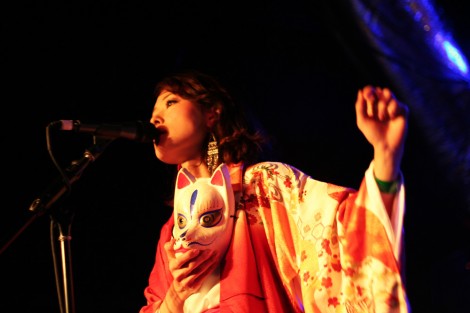

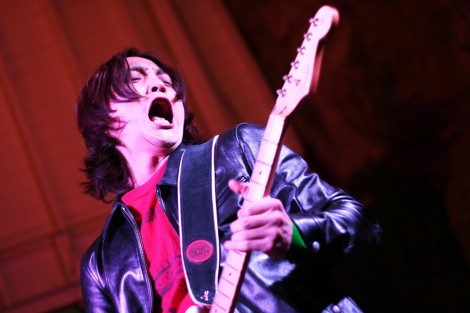
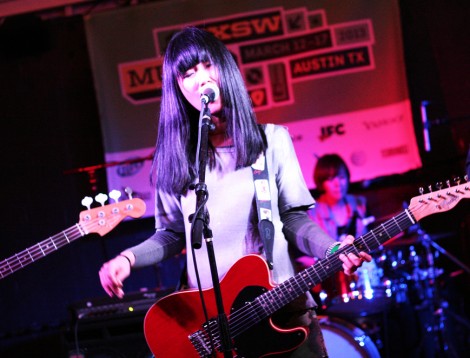

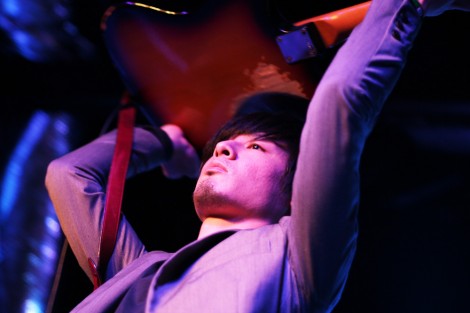
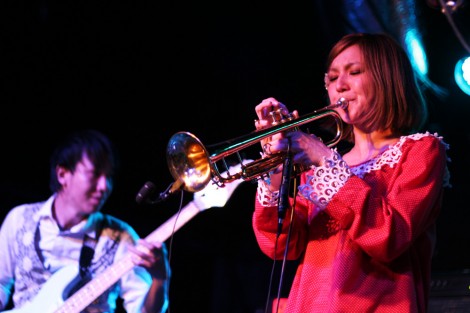
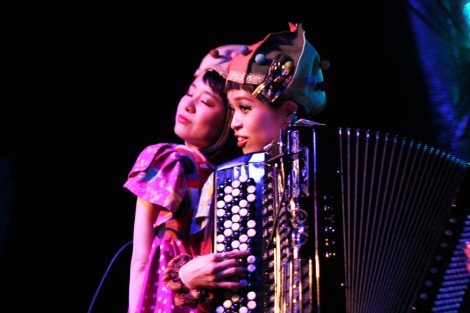


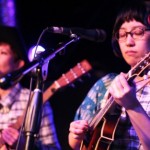 Previous
Previous 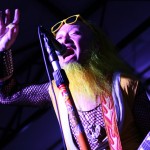 Next
Next 